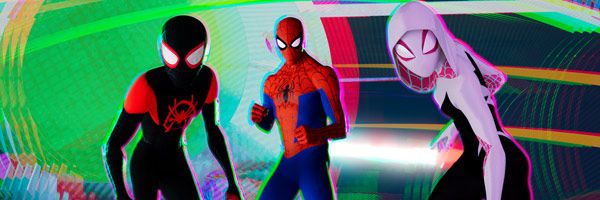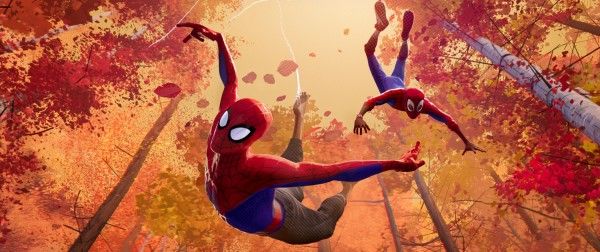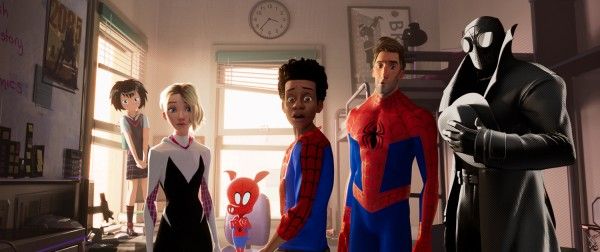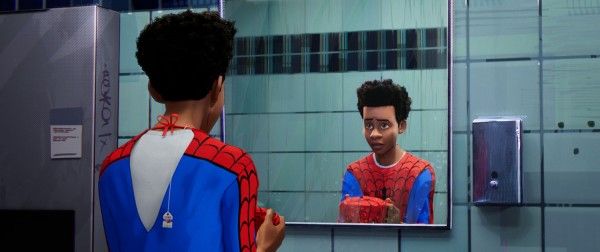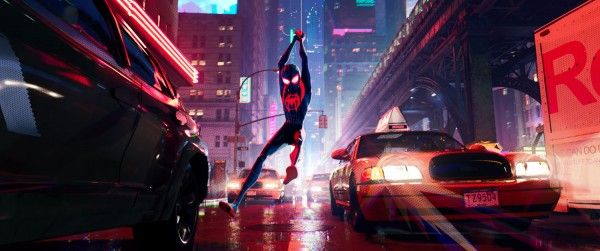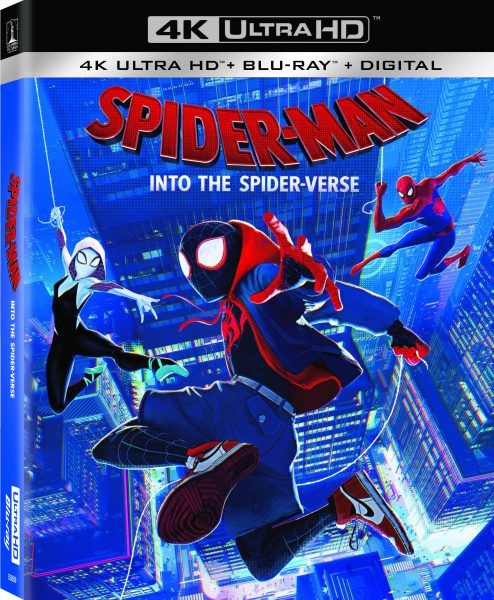Few studio films have pushed the boundaries of animation in recent years the way that Sony Pictures Animation's Spider-Man: Into the Spider-Verse does. Produced by Phil Lord and Chris Miller, the creative duo behind surprising, genre-bending, and seemingly ill-advised hits like The Lego Movie and 21 Jump Street, the animated Spider-Man movie triumphed as the underdog superhero sensation last year and just took home for Best Animated Picture at the 91st Academy Awards.
Which means it's a pretty good time to be Bob Persichetti, Peter Ramsay, and Rodney Rothman -- the directorial trio that brought the wonderous multiverse of Into the Spider-Verse to life. Working with Lord and Miller (and a massive team of animators and effects artists,) the trio transformed one of cinema's most familiar superheroes into the foundation for a singular, unpredictable animated film, finally introducing comic book favorites Miles Morales and Spider-Gwen on screen -- not to mention taking wild swings with characters like Spider-Ham, Spider-Man Noir, and two Peter Parkers.
Just a few days before Into the Spider-Verse took home the Oscar gold, I sat down with the directorial trio at a press day for the film's home video release. We talked about if they've considered the possible continuity butterfly effect of their alternate universe Easter Eggs, their personal favorite Easter Eggs, and the 160-page early draft of the script. And, with demand for a sequel on full blast, they also discussed the importance of taking an innovative approach to their creative process and their ambition to continue that tradition in future films.
You guys filled this film with Easter Eggs, especially in creating other dimensions. Did you have any concerns about a sort of butterfly effect of continuity in the future with how many specific details you'd have to remember?
RODNEY ROTHMAN: Zero.
BOB PERSICHETTI: That is someone else's problem [Laughs].
ROTHMAN: That's like if you stay up late and you're like, “It's tomorrow's me's problem. It's not me.” As you doze off, you see yourself waking up going, “Ah, shoot.” It's some other dude's problem!
What is your favorite of the more hidden Easter eggs that people should look for?
PETER RAMSEY: I'm an old comic book fan, so that every time that someone pulls out their phone and you see their contacts, there's some pretty good Easter eggs in there.
PERSICHETTI: My favorites are not Easter eggs for anyone else, other than me, but just because I put my kids and my wife's name in the movie, in the Graffiti scene, in the tunnels, just because I could. It's so I could say, “Hey, I was thinking about you when I wasn't around. I promise, remember?"
ROTHMAN: I have a favorite Easter egg. I really do. I mean, there's lots that I think are cool, but I have a favorite Easter egg which is that, when Miles reads Great Expectations, the cover of the book shows a scene from Great Expectations, where you see Pip, getting approached by someone ...
RAMSEY: Magwitch.
ROTHMAN: Yeah, by Magwitch, in a cemetery. Just like he's approached by Peter in a cemetery. Yeah. That's actually, I thought that was really cool. We picked that book before, I think it was you [Peter], that called out the visual allusion.
I think I saw in a report that there was a previous idea for the film with up to ten spider-people in it... [they shake their heads no]. No? Not true?
ROTHMAN: No. There was a previous draft of the script that was 160 pages long, though.
PERSICHETTI: Yeah, we had a three-hour movie.
ROTHMAN: There you go.
Wow, what was the biggest change to come out of that?
PERSICHETTI: Structure, essentially. I mean, we had this real, sort of, recurring, almost spiral, of a first act, that was like 75 minutes.
RAMSEY: A lot of jumping back and forth in time. We kind of got streamlined to the idea, or the spirit of it kind of got streamlined down to our recurring character intros.
PERSICHETTI: Yeah, we are big fans long first act generally as far as like, just texture, detail, introduction of characters and situations, but early versions of the movie, took that to an unnecessary extreme.
ROTHMAN: Yeah yeah yeah definitely. And, we, in that version there was also, Miles' roommate played a much larger role. We kind of carved that out.
When you think about the future of these films -- you guys helped create something really unique in the realm of animation, in the way it looks, the way it feels, so how much do you guys think about balancing what people loved about the innovation in this film, versus continuing to innovate and not doing the same thing again?
PERSICHETTI: That's a great question. It's a tightrope.
ROTHMAN: Yeah, it's a tightrope. I think going into, you know, since you know it's so early, you know to think about something like that, I would say that the goal is to do ... to deepen both sides of that equation, you know? To deepen the emotional storytelling, and you know, the story about Miles and his family, just deepen all that, and deepen the sense of experimentation and pushing boundaries visually, and I'm sure there'll be tethers to what we just did, but I think the hope is that we feel super encouraged by how people responded to the risks that we took, we didn't know if they were gonna work or not, so I think everyone feels emboldened.
PERSICHETTI: Yeah, I think it becomes about, you know, continue the philosophy of the way the movie got made, as opposed to continue making movies that look the same. Because the way the movie - every choice we made, in pushing the boundaries on the animation style and the visual stylization, even the narrative stylization, all of that stuff was a choice that felt like it was born out of the needs for the story and the movie narratively, and obviously it all compounded to make something feel really cohesive and resonant. If you can take that philosophy forward, that's the win.
ROTHMAN: Right. The addictive part of this is the intensity of people's reactions. You know, emotionally. That's addictive. You go through that, what we've gone through for the last few months, I'll speak for myself, I've never gone through that before, and you go through that, and you don't wanna work on anything that doesn't at least have a chance of meaning something to people and connecting with them.
RAMSEY: Yeah, it's a trick. It's an interesting place to be.
Spider-Man: Into the Spider-Verse is now available on Digital and lands on Blu-ray March 19th.

